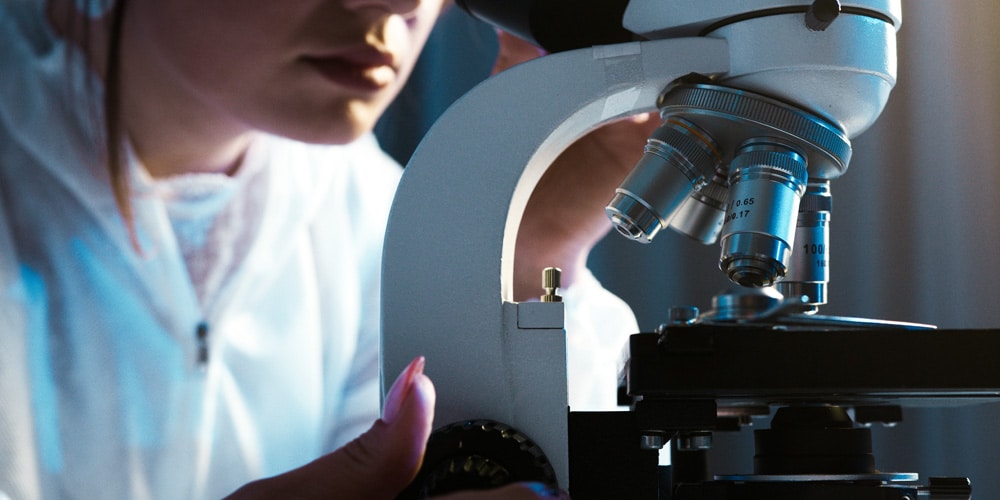Until recently, we were unable to identify precisely the negative information that androgens transmit to hair follicles. We could only observe the symptoms (described below). Since then, researchers have been able to identify a number of molecules that are inhibited by androgens and to determine the moment in the hair cycle when androgens exert their inhibition. This is enough to repair the damage caused, and to do so more effectively than ever before!
CONTEXT OF ANDROGENETIC ALOPECIA
The statistics speak for themselves: androgenetic hair loss accounts for more than 95 % of cases of hair loss in men and 90 % of cases in women. Worldwide, 70 % of men and 40 % of women develop more or less severe alopecia at some point in their lives.
Androgenetic loss is caused by a hormonal dysfunction in the hair follicle, the organ that produces keratin hair. This dysfunction leads to the metabolisation (transformation) of circulating testosterone into a new hormone, DHT (dihydrotestosterone), driven by a local enzyme, 5-α reductase. Via the bloodstream, DHT, a highly damaging hormone, sends a series of negative signals to the dermal papilla of the hair follicle, disrupting the three successive phases of the hair growth process. life cycle capillaries (anagen, catagen, telogen).
This information sends the follicle into a frenzy of production. The hair factory goes into overdrive. This has two consequences: hair falls out more and more prematurely, and new growth becomes thinner and more ephemeral. Eventually, exhausted, the follicles become miniaturised and end up producing nothing more than a fine fuzz, and then nothing at all. At the end of the process, the inactive follicles sink into the dermis and the skin becomes smooth.
STUDY OF STEM CELLS IN ANDROGENETIC ALOPECIA
Until now, scientists thought that hair follicles, under the action of androgens, lost more and more stem cells as the disorder progressed.
To verify this hypothesis, researchers at the University of Pennsylvania carried out a study in 2011 on a sample of human scalps suffering from alopecia moderata. They compared their alopecic follicles, taken from the balding areas, with healthy follicles taken from the hairy areas. They were surprised to discover that all the follicles, whether alopecic or not, had on average the same quantity of stem cells. In the keratinisation zone, however, the stem cells from alopecic follicles are unable (or no longer able) to mobilise themselves to transform into hair progenitor cells.
Conclusion
It is not the number of stem cells in diseased follicles that is decreasing and causing hair miniaturisation, but their increasing inability to convert into active progenitor cells. It is therefore essential to understand why these stem cells are finding it increasingly difficult to become active, in order to start a new growth (at the end of the telogen phase) and allow it to develop thereafter. Read our article here.
MOLECULES INHIBITED BY DHT DURING AN ANDROGENETIC CYCLE
Starting with the telogen phase of an affected follicle, we can see that DHT has a negative effect on all the proteins currently identified as key players in the birth and growth of hair.
Here are the details:
- DHT partially inhibits the β-catenin and Shh proteins. Normally, these two proteins trigger the awakening of stem cells and recruit those that need to proliferate downwards to allow the follicle to lengthen. As a result, the telogen phase, before the start of a new cycle, can become pathologically lazy and last for many months, even after the hair has fallen out. This is an anomaly that researchers are currently focusing all their attention on. One of the plants in the Clauderer 6R Serum (exclusive CERES-1 bio-complex) has the ability to stimulate the β-catenin and Shh proteins, so that the length of the telogen phase returns to normal.
- DHT deregulates the VEGF protein, which normally increases vascularisation of the papillae and blood flow to the follicle. As a result, in an affected follicle, the hair regrowth is less well fed and lacks vigour.
- DHT partially inhibits the IGF1 and KGF protein pair. The former regulates follicle development throughout hair growth. The second is directly involved in the differentiation of stem cells into progenitor cells and influences the growth and calibre of the hair shaft. Both also control the rate of follicle production during the anagen phase of hair growth, preventing the hair from entering the catagen phase before its time. Consequence: in an affected follicle, keratin production is increasingly sloppy and the hair thins inexorably.
- DHT slows down the activity of the TERC protein, whose function is to prevent the physiological ageing of the body's cells in general, and those of the hair follicle in particular. As a result, in an androgenetic follicle, the hair follicle atrophies a little more with each cycle, producing less and less dense keratin.
- DHT triggers the expression of the TGF-β protein, nicknamed the "assassin protein" because it initiates the hair's catagen phase too early. As a result, the hair will fall out before its time, shortening its lifespan even further.


Thank you for these very interesting details on the precise action of DHT.
So what are the most effective ways of curbing these actions?
For example, can cysteine, which is active in the production of keratin, offset the effects of DHT?
Suffering from alopecia, I'm looking for ways to go further.
Thank you for your answers.
Thank you for your message. At Clauderer, we favour a multi-factorial approach, as no single element can combat the negative effects of DHT on its own. By combining vitamins, active ingredients extracted from several plants and other ingredients, we can provide a global solution to the consequences of androgenism. The Clauderer Team.